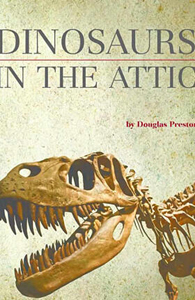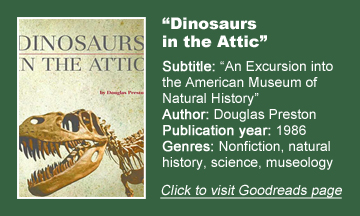Although he didn’t know it at the time, Douglas Preston’s nonfiction book “Dinosaurs in the Attic: An Excursion into the American Museum of Natural History” (1986) plays as a collection of research notes and ideas for his later career as a novelist.
That wouldn’t begin for another eight years, with “Jennie,” the seeds of which are found here in chapter 11’s recounting of Meshie Mungkut, the first example of a chimpanzee raised as a human.
Writing what he knows
“Dinosaurs” – which, be warned, is only partially about the titular animals — is proof positive that Preston, adhering to that fiction-writing adage, would go on to “write what he knows.” It’s fun to see the roots of his novel ideas, but the chapters here are more academic than what we’d get in fiction form.
On the other hand, each segment is fairly short, so the book plays as Preston intends: as a variety pack of tales about adventurous expeditions and fascinating facts as he informally ventures through the museum (which becomes the New York Museum of Natural History in the Preston & Child books and goes by its real name in Preston’s solo books).
The tome might play better for people who have seen the exhibit or object before reading the section on it, and it’s unfortunate that the photos in the middle are low-quality, old black-and-whites.
Exploring the back rooms
Many of the chapters aren’t about an exhibit, but instead items in the attics, backrooms and bowels of the buildings, the places that make such great settings in his fiction, as we first learned in “Relic.” Besides, less than 1 percent of the collection is on display.
As I learned a lot about specific topics – the search for a hypothesized continent between Canada and Siberia, the aim of recording creation myths before remote cultures are wiped out, and the perils of fossil collecting in Wyoming and Mongolia – I also absorbed the purpose of the museum.
Preston says it exists to collect knowledge, not objects for the sake of the object (as an art museum would do). Most items have a recorded history, and its value is based on what the object means.
Historic gems
One arguable exception is the gem and mineral collections (some items of which have sketchy histories), and Preston chronicles the heist of a good chunk of the museum’s stash – something that inspired a similar theft in “Dance of Death.”
I’m always amused at Preston and Child’s writings about massive treasure rooms (“Riptide” includes a prime example); clearly gems are a particular passion of Preston’s.
I was also reminded of how other thriller authors draw from history for their stories. Preston’s recounting of the early dinosaur-bone hunters calls to mind Michael Crichton’s “Dragon Teeth,” and his report on Arctic exploration made me think of Dan Simmons’ “The Terror.”
I think P&C fans will enjoy “Dinosaurs” because their areas of interest already overlap with Preston’s, as evidenced by the fact that they keep picking up his books. Being dryly journalistic, it lacks the page-turning power of Preston’s later works, when he became a zestier writer.
Still, it’s great to have “Dinosaurs in the Attic” as a reference guide to so many of his fictional artifacts and adventures (although the reader has to make the connections themselves, of course).



